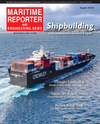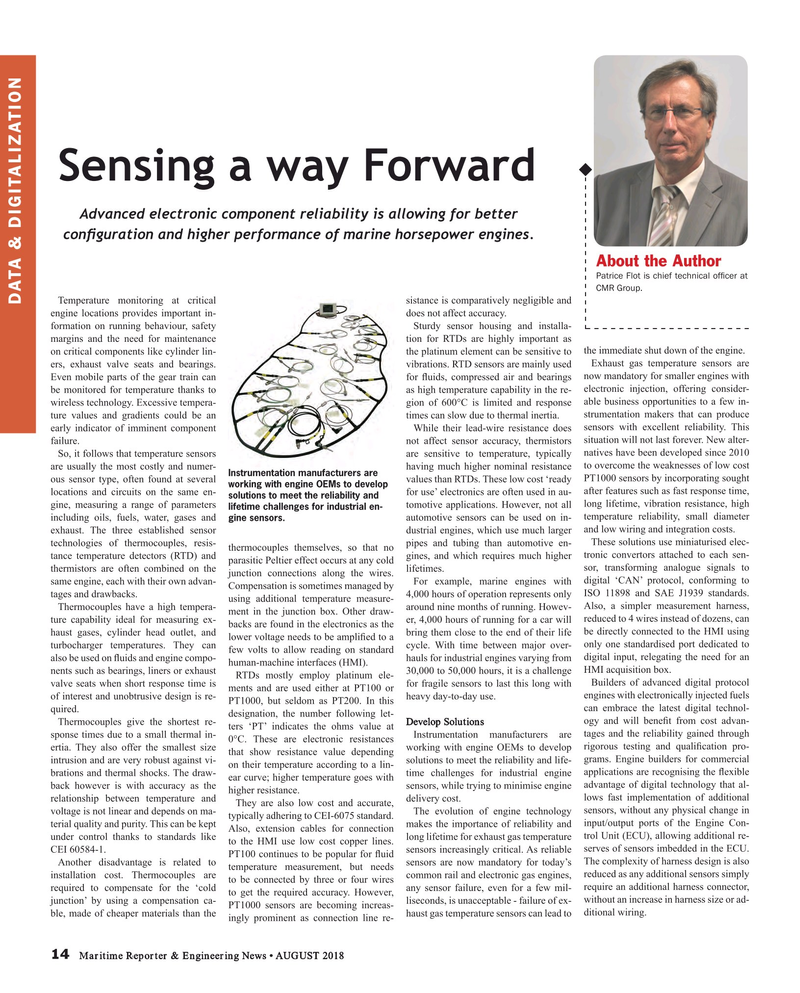
Page 14: of Maritime Reporter Magazine (August 2018)
The Shipyard Edition
Read this page in Pdf, Flash or Html5 edition of August 2018 Maritime Reporter Magazine
Sensing a way Forward
Advanced electronic component reliability is allowing for better con? guration and higher performance of marine horsepower engines.
About the Author
Patrice Flot is chief technical of? cer at
CMR Group.
Temperature monitoring at critical sistance is comparatively negligible and
DATA & DIGITALIZATION engine locations provides important in- does not affect accuracy.
formation on running behaviour, safety Sturdy sensor housing and installa- margins and the need for maintenance tion for RTDs are highly important as on critical components like cylinder lin- the platinum element can be sensitive to the immediate shut down of the engine.
Exhaust gas temperature sensors are ers, exhaust valve seats and bearings. vibrations. RTD sensors are mainly used
Even mobile parts of the gear train can for ? uids, compressed air and bearings now mandatory for smaller engines with electronic injection, offering consider- be monitored for temperature thanks to as high temperature capability in the re- wireless technology. Excessive tempera- gion of 600°C is limited and response able business opportunities to a few in- strumentation makers that can produce ture values and gradients could be an times can slow due to thermal inertia.
early indicator of imminent component
While their lead-wire resistance does sensors with excellent reliability. This failure. not affect sensor accuracy, thermistors situation will not last forever. New alter-
So, it follows that temperature sensors are sensitive to temperature, typically natives have been developed since 2010 are usually the most costly and numer- having much higher nominal resistance to overcome the weaknesses of low cost
Instrumentation manufacturers are ous sensor type, often found at several values than RTDs. These low cost ‘ready PT1000 sensors by incorporating sought working with engine OEMs to develop after features such as fast response time, locations and circuits on the same en- for use’ electronics are often used in au- solutions to meet the reliability and gine, measuring a range of parameters tomotive applications. However, not all long lifetime, vibration resistance, high lifetime challenges for industrial en- temperature reliability, small diameter including oils, fuels, water, gases and automotive sensors can be used on in- gine sensors.
exhaust. The three established sensor dustrial engines, which use much larger and low wiring and integration costs.
These solutions use miniaturised elec- technologies of thermocouples, resis- thermocouples themselves, so that no pipes and tubing than automotive en- tance temperature detectors (RTD) and parasitic Peltier effect occurs at any cold gines, and which requires much higher tronic convertors attached to each sen- sor, transforming analogue signals to thermistors are often combined on the junction connections along the wires. lifetimes. same engine, each with their own advan-
For example, marine engines with digital ‘CAN’ protocol, conforming to
Compensation is sometimes managed by tages and drawbacks. 4,000 hours of operation represents only ISO 11898 and SAE J1939 standards. using additional temperature measure-
Also, a simpler measurement harness,
Thermocouples have a high tempera- around nine months of running. Howev- ment in the junction box. Other draw- ture capability ideal for measuring ex- er, 4,000 hours of running for a car will reduced to 4 wires instead of dozens, can backs are found in the electronics as the haust gases, cylinder head outlet, and lower voltage needs to be ampli? ed to a bring them close to the end of their life be directly connected to the HMI using only one standardised port dedicated to turbocharger temperatures. They can few volts to allow reading on standard cycle. With time between major over- also be used on ? uids and engine compo- hauls for industrial engines varying from digital input, relegating the need for an human-machine interfaces (HMI).
nents such as bearings, liners or exhaust 30,000 to 50,000 hours, it is a challenge HMI acquisition box.
RTDs mostly employ platinum ele-
Builders of advanced digital protocol valve seats when short response time is ments and are used either at PT100 or for fragile sensors to last this long with engines with electronically injected fuels of interest and unobtrusive design is re- PT1000, but seldom as PT200. In this heavy day-to-day use.
can embrace the latest digital technol- quired.
designation, the number following let- ogy and will bene? t from cost advan-
Thermocouples give the shortest re- ters ‘PT’ indicates the ohms value at Develop Solutions sponse times due to a small thermal in-
Instrumentation manufacturers are tages and the reliability gained through 0°C. These are electronic resistances ertia. They also offer the smallest size that show resistance value depending working with engine OEMs to develop rigorous testing and quali? cation pro- grams. Engine builders for commercial intrusion and are very robust against vi- solutions to meet the reliability and life- on their temperature according to a lin- brations and thermal shocks. The draw- ear curve; higher temperature goes with time challenges for industrial engine applications are recognising the ? exible back however is with accuracy as the higher resistance. sensors, while trying to minimise engine advantage of digital technology that al- lows fast implementation of additional relationship between temperature and They are also low cost and accurate, delivery cost. voltage is not linear and depends on ma-
The evolution of engine technology sensors, without any physical change in typically adhering to CEI-6075 standard. terial quality and purity. This can be kept
Also, extension cables for connection makes the importance of reliability and input/output ports of the Engine Con- trol Unit (ECU), allowing additional re- under control thanks to standards like to the HMI use low cost copper lines. long lifetime for exhaust gas temperature
CEI 60584-1. sensors increasingly critical. As reliable serves of sensors imbedded in the ECU.
Another disadvantage is related to PT100 continues to be popular for ? uid installation cost. Thermocouples are temperature measurement, but needs sensors are now mandatory for today’s The complexity of harness design is also to be connected by three or four wires common rail and electronic gas engines, reduced as any additional sensors simply require an additional harness connector, required to compensate for the ‘cold to get the required accuracy. However, any sensor failure, even for a few mil- without an increase in harness size or ad- junction’ by using a compensation ca- liseconds, is unacceptable - failure of ex-
PT1000 sensors are becoming increas- ditional wiring.
ble, made of cheaper materials than the ingly prominent as connection line re- haust gas temperature sensors can lead to 14 Maritime Reporter & Engineering News • AUGUST 2018
MR #8 (10-17).indd 14 MR #8 (10-17).indd 14 8/6/2018 11:13:40 AM8/6/2018 11:13:40 AM

 13
13

 15
15
